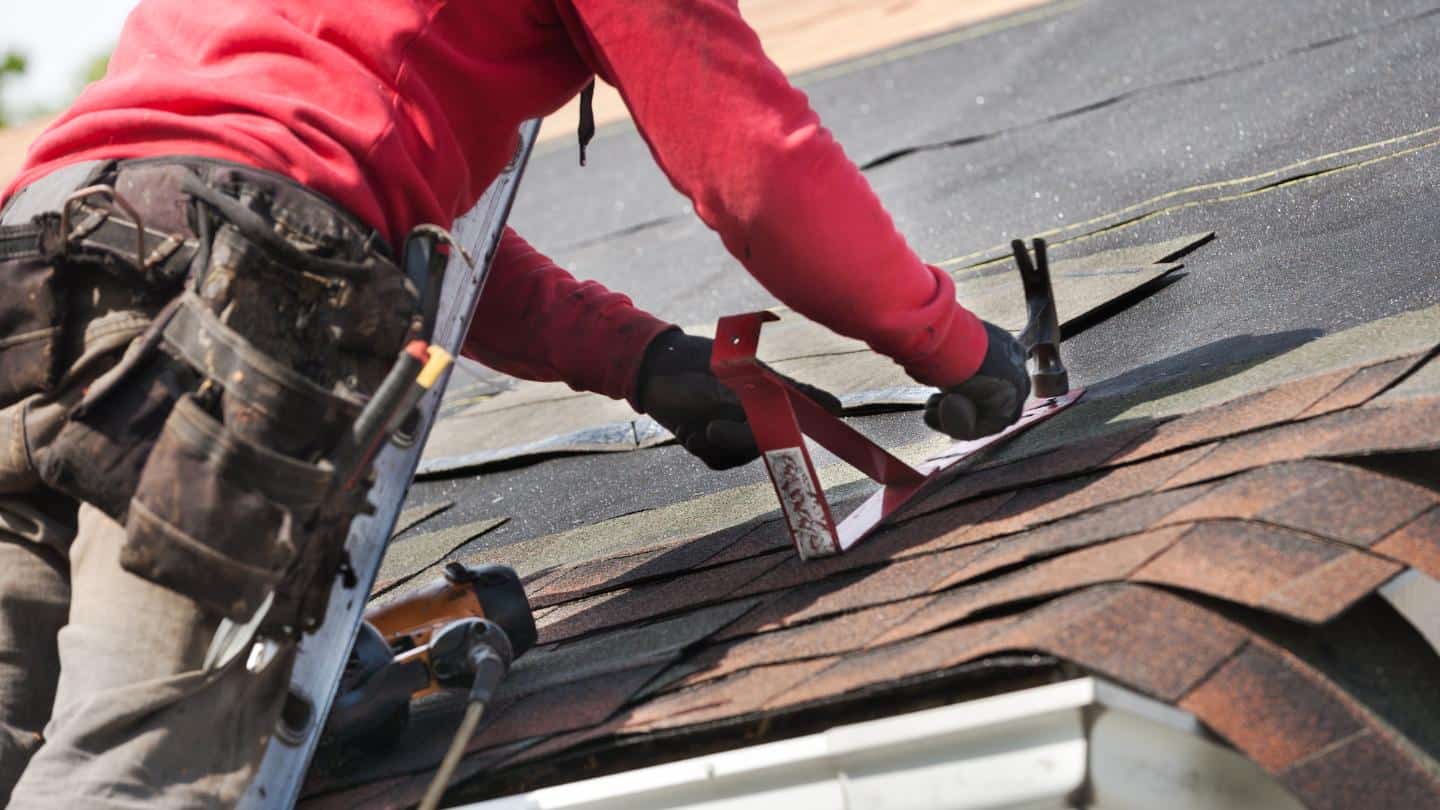When storms are on the horizon, you’re likely to batten down the hatches and secure your home’s windows and doors. But did you ever stop to think about your roof? It’s your primary line of defense against the elements, so ensuring it’s in top shape before a storm hits is crucial to minimizing potential damage.
In this article, we’ll guide you through the steps necessary to prepare your roof for a storm. We’ll help you assess its current condition, pinpoint any weak spots that might need attention, and demonstrate how to clean and secure your gutters. Furthermore, we’ll explain why checking and repairing flashing matters, show you how trimming surrounding trees can protect your roof during high winds, teach you how to secure loose objects that could become flying debris, and finally outline an effective regular maintenance plan.
Evaluating the Condition of the Roof
Before you can prep for any storm, you’ve got to get a good look at your roof’s current state – it’s like checking the health of a shield before going into battle. Start by assessing the durability of your roof material. Whether it’s slate, tile, wood shingles or metal, each type has its own lifespan and ability to withstand harsh weather conditions. Don’t hesitate to bring in a professional if you’re unsure about what kind of shape your roof is in; they’ll be able to provide a thorough inspection and offer advice tailored to your specific situation.
In addition to inspecting the surface materials, consider other elements that contribute to the overall condition of your roof such as gutters, downspouts and flashings. Evaluate these areas for any signs of wear and tear or potential weak points that could compromise the structure during a storm. Conducting this lifespan assessment will help pinpoint which parts may need reinforcing or replacing ahead of time – it’s better safe than sorry when dealing with Mother Nature’s wrath!
Identifying Potential Weak Spots

Feeling safe and secure in your home is paramount, so let’s pinpoint those sneaky vulnerabilities on the top of your house that could give way under violent weather conditions. Spotting leaks is crucial to this process. You can typically identify these by looking for water stains on the ceiling or walls. If you spot any, it’s a clear indication that water has found its way through your roofing system. Don’t dismiss small leaks; they can quickly escalate into bigger problems during a storm.
Another critical aspect to check is the structural integrity of your roof. This means checking for loose, missing, or damaged shingles as well as any signs of rot or rust on metal parts. Pay particular attention to areas around vents and chimneys where wear and tear are most common. These weak spots may not be obvious at first glance but can drastically compromise the ability of your roof to withstand heavy winds and rain when a storm hits. So make sure you’ve got every inch covered!
Cleaning and Securing Gutters
Don’t underestimate the power of clean and secure gutters – they’re your home’s first line of defense against water damage! Clearing out leaves, twigs, and any other debris that could potentially clog your gutters is a top priority. Clogged gutters can cause water to overflow and seep into your house’s foundation or interior. Furthermore, consider a gutter guards installation. These devices are designed to keep debris out while allowing rainwater to flow freely.
In addition to cleaning your gutters, securing them properly is equally important. Loose or damaged parts can become lethal projectiles during strong winds. Make sure the fasteners holding your gutter in place are secure and replace any that are missing or damaged. Pay special attention to downspout maintenance as well – it should be firmly attached and directed away from your home’s foundation to prevent water damage there too. Regular checks for cracks or holes in both gutters and downspouts will help ensure their integrity in protecting your home from storm damage.
Checking and Repairing Flashing
When it comes to safeguarding your home against the elements, checking and repairing flashing is a crucial task you can’t afford to overlook. Flashing, typically made of metal, is installed around areas like chimneys, vents and skylights where water penetration may occur. It’s a simple yet effective barrier that helps keep water from seeping into your house during a storm. You’ll need to familiarize yourself with different flashing installation techniques and material options that best suit your home’s needs.
First off, examine the condition of your existing roof flashing. If it’s bent, rusted or damaged in any way consider replacing it before the storm hits. When choosing new flashing material options, you’ve got several choices: aluminum is cost-effective but less durable; copper is sturdier but more expensive; while galvanized steel strikes a good balance between durability and cost-effectiveness. The correct application of these materials using proven flashing installation techniques will significantly reduce the chances of water infiltration during harsh weather conditions. Remember, well-maintained roof flashing not only keeps leaks at bay but also prolongs the overall lifespan of your roof.
Trimming Surrounding Trees
Protecting your home from potential hazards also includes taking a good look at the trees surrounding it. A tree health assessment is essential for preventing storm damage to your roof. Large branches hanging over your property can pose a significant risk during high winds or heavy snowfall. Even healthy trees can cause problems if they’re too close to your house, so it’s important to assess their placement as well as their overall health.
Pruning techniques come in handy when trimming back potentially dangerous branches. Regularly pruning not only keeps your trees healthy but also reduces the likelihood of a branch causing damage during a storm. It’s best to hire professionals for this task, especially for larger trees, as improper pruning can lead to tree disease and other issues down the line. Remember that while you can’t predict every possible outcome from a storm, adequately preparing your trees will go a long way in minimizing potential roof damage.
Securing Loose Objects

In addition to tree management, it’s also crucial to secure any loose objects around your home that could potentially become airborne in high winds and cause harm. Your anchor placement strategy plays a key role here, as you need to strategically secure items that are light or not grounded well enough to withstand stormy winds. This includes everything from outdoor furniture and grills to garden tools or decorations. Using sturdy ropes tied down tightly and anchored securely is often a good approach. Remember, the idea is not just about preventing these items from being swept away but also protecting your roof from possible damage they might cause when tossed around.
Now let’s talk about materials. For any outdoor structures or fixtures near your house, wind-resistant materials can make a significant difference during storms. These materials are designed to resist the force of high-speed winds without breaking apart or becoming projectiles that can damage your roof. Consider replacing or reinforcing lighter structures with heavier ones made of these sturdier materials if possible. Be proactive; don’t wait for a storm warning before you start securing things around your home – by then, it might be too late! Try incorporating these preventative measures into your regular home maintenance routine so you’re always prepared for whatever Mother Nature throws at you.
Implementing a Regular Maintenance Plan
Don’t you think it’s a smart move to get ahead of the game by implementing a regular maintenance plan? It doesn’t just save you from costly repairs, but also guards your roof against potential storm damage. By incorporating preventive measures into your routine, you can identify and fix minor issues before they turn into major problems. This process includes regular inspections for any signs of wear and tear or damages caused by weather conditions.
Your maintenance schedule should include biannual checks, ideally during spring and fall seasons when the weather is milder. During these times, clean your gutters, inspect for loose or missing shingles, check flashings for damage, and trim overhanging branches that could potentially harm your roof during a storm. Remember, consistency in carrying out these tasks can make all the difference in how well your roof withstands a storm. Maintaining isn’t merely fixing; it’s taking proactive steps to ensure longevity.
Conclusion
As you can see, preparing your roof for a storm isn’t rocket science. It’s all about regular check-ups, spotting potential weak spots, and making timely repairs. Don’t overlook the importance of cleaning and securing gutters or trimming any threatening trees.
When the storm hits, you’ll be glad you took these precautions. Remember, it’s not just about minimizing damage; it’s also about ensuring your family’s safety. So don’t wait – start implementing a regular maintenance plan today!














